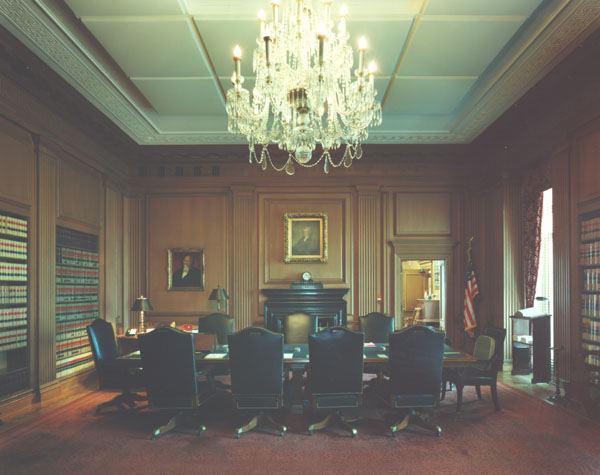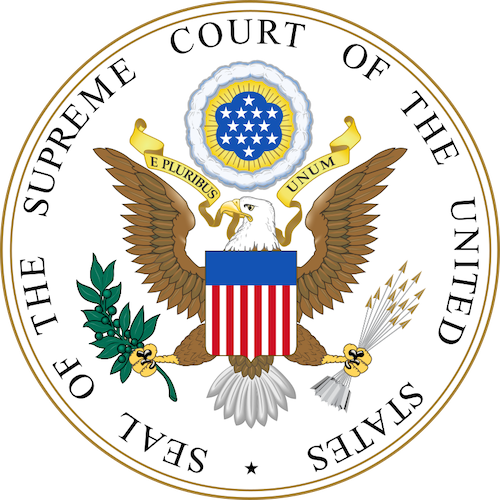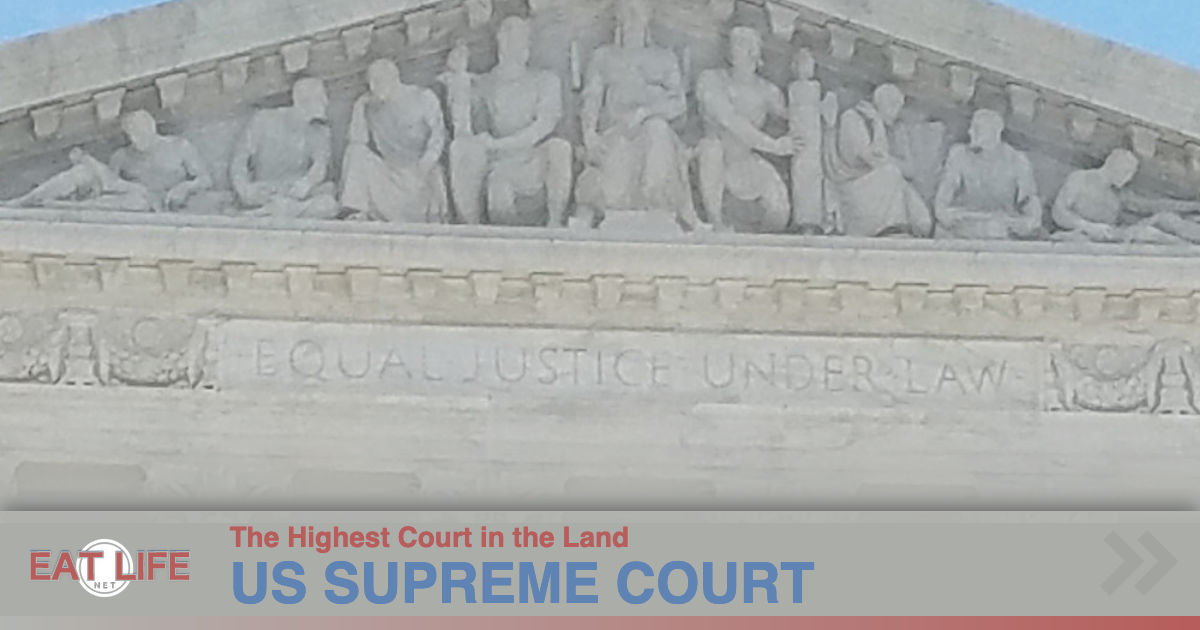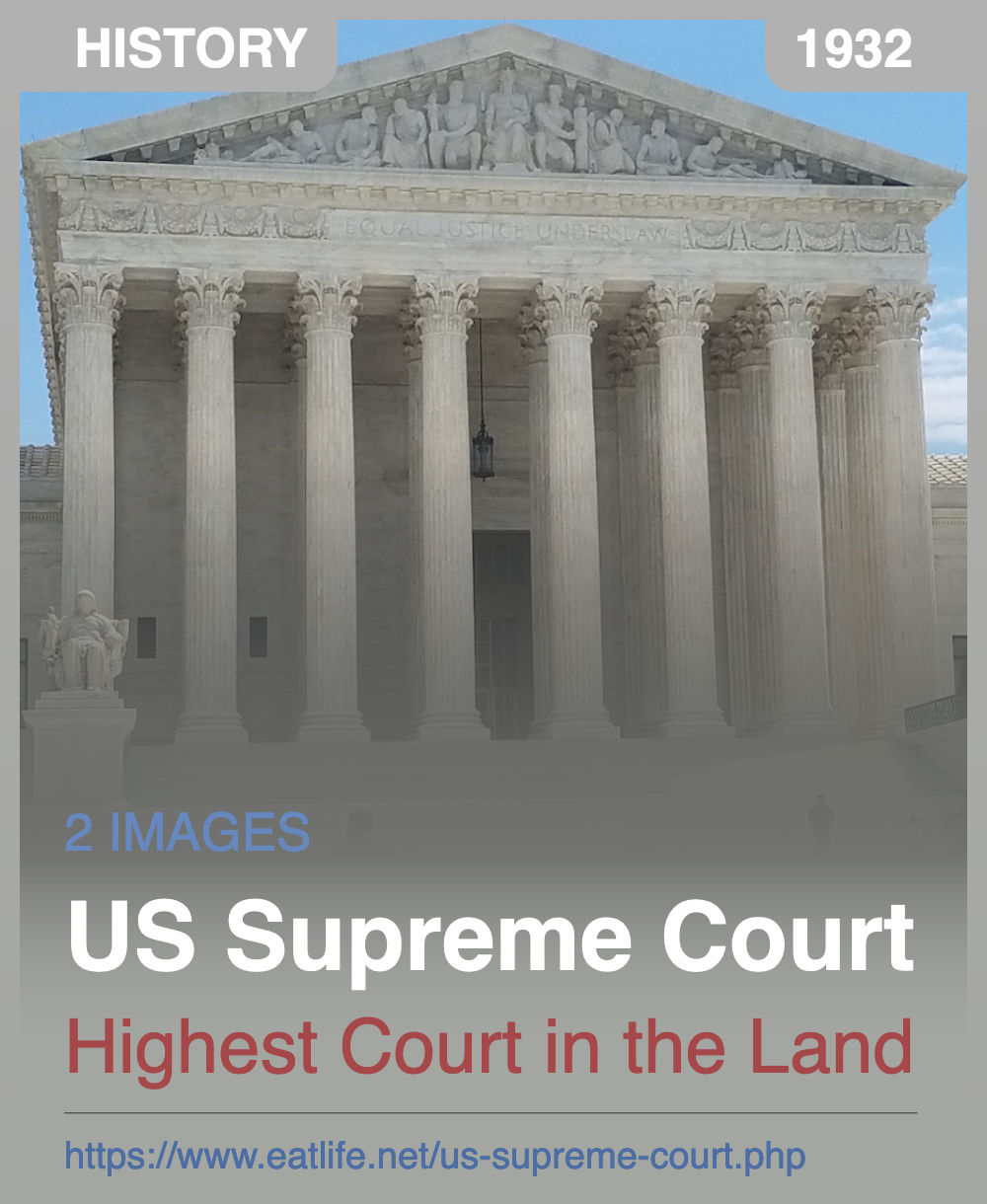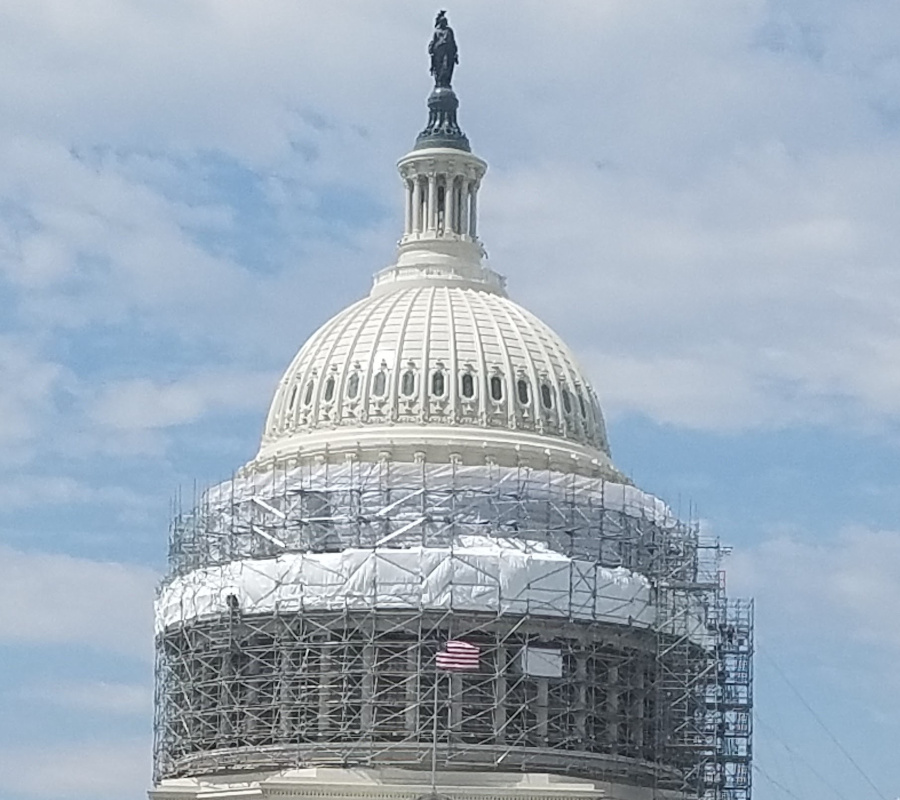Supreme Court of the United States:
The highest judicial body in the country and leads the judicial branch of the federal government. It is often referred to by the acronym SCOTUS.The Supreme Court consists of nine justices: the Chief Justice of the United States and eight Associate Justices. The justices are nominated by the president and confirmed with the "advice and consent" of the United States Senate per Article II of the United States Constitution. As federal judges, the justices serve during "good behavior," which means that justices have tenure for life unless they are removed by impeachment and subsequent conviction.
The Supreme Court is the only court established by the United States Constitution (in Article III); all other federal courts are created by Congress.
The Supreme Court meets in Washington, D.C., in the United States Supreme Court building. The Supreme Court's yearly term begins on the first Monday in October and lasts until the first Monday in October the following year. The court generally releases the majority of its decisions in mid-June.
Article III of the United States Constitution:
Section 1:The judicial Power of the United States shall be vested in one supreme Court, and in such inferior Courts as the Congress may from time to time ordain and establish. The Judges, both of the supreme and inferior Courts, shall hold their Offices during good Behaviour, and shall, at stated Times, receive for their Services a Compensation, which shall not be diminished during their Continuance in Office.
Section 2:The judicial Power shall extend to all Cases, in Law and Equity, arising under this Constitution, the Laws of the United States, and Treaties made, or which shall be made, under their Authority; - to all Cases affecting Ambassadors, other public Ministers and Consuls; - to all Cases of admiralty and maritime Jurisdiction; - to Controversies to which the United States shall be a Party; - to Controversies between two or more States; - between a State and Citizens of another State, - between Citizens of different States, - between Citizens of the same State claiming Lands under Grants of different States, and between a State, or the Citizens thereof, and foreign States, Citizens or Subjects.
In all Cases affecting Ambassadors, other public Ministers and Consuls, and those in which a State shall be Party, the supreme Court shall have original Jurisdiction. In all the other Cases before mentioned, the supreme Court shall have appellate Jurisdiction, both as to Law and Fact, with such Exceptions, and under such Regulations as the Congress shall make.
The Trial of all Crimes, except in Cases of Impeachment, shall be by Jury; and such Trial shall be held in the State where the said Crimes shall have been committed; but when not committed within any State, the Trial shall be at such Place or Places as the Congress may by Law have directed.
Section 3:Treason against the United States, shall consist only in levying War against them, or in adhering to their Enemies, giving them Aid and Comfort. No Person shall be convicted of Treason unless on the Testimony of two Witnesses to the same overt Act, or on Confession in open Court.
The Congress shall have Power to declare the Punishment of Treason, but no Attainder of Treason shall work Corruption of Blood, or Forfeiture except during the Life of the Person attained.
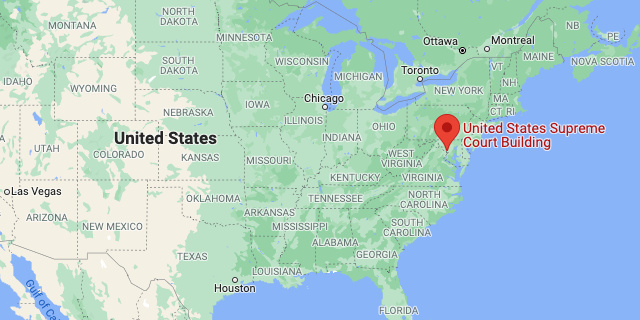
google.com/maps/place/United+States+Supreme+Court+Building
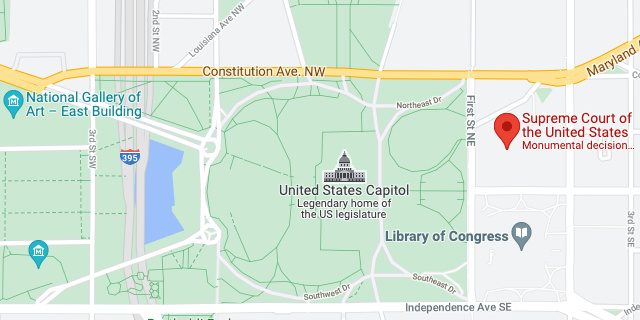
google.com/maps/place/Supreme+Court+of+the+United+States
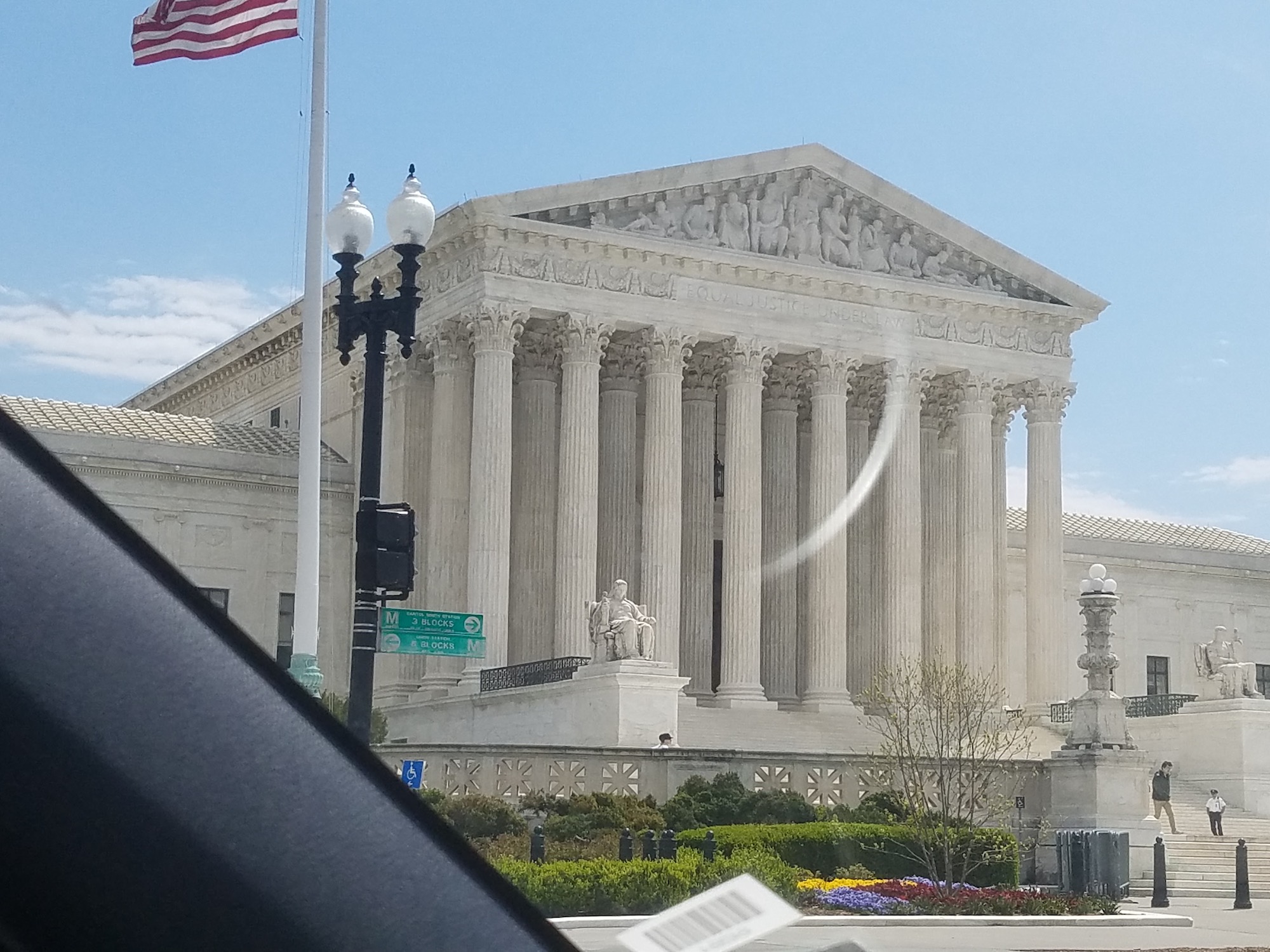
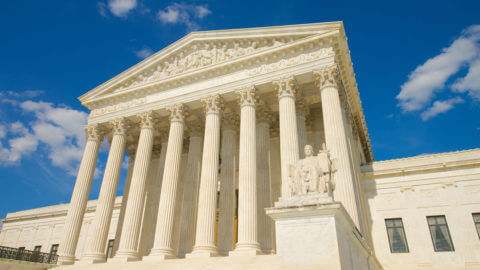
The neoclassical structure was built in 1935 to become the permanent home to the Supreme Court.
Despite its central role as one of the three main branches of government outlined in the U.S. Constitution, the Supreme Court did not have its own venue to conduct business for the first 145 years of its existence. The Court initially met in the Merchants Exchange Building while the capital was located in New York. When the nation's capital moved to Philadelphia beginning in 1790, the Court met in Independence Hall and City Hall. With the establishment of the federal city 10 years later, the Supreme Court occupied chambers in various parts of the Capitol Building. It would also convene in a private residence for a short time after British soldiers burned Washington, D.C. during the War of 1812. The Court would return to the Capitol and occupy the Old Supreme Court Chamber from 1819 until 1860. With expansion of the Capitol, the Court was relocated and convened in the Old Senate Chamber from 1860 until 1935.
Former president and then Chief Justice of the Supreme Court, William Howard Taft persuaded Congress in 1929 to authorize the construction of a separate building for the Court. Architect Cass Gilbert was selected to design the new federal building. The construction project began in 1932. Neither Taft nor Gilbert survived to see the completed building, which was finished in 1935. Chief Justice Charles Hughes and Cass Gilbert, Jr. oversaw the construction of the new Courthouse, which was completed under budget.
Taft had asked Gilbert to design a building that reflected the dignity and importance of the Court. The classical Corinthian-style architecture easily blends with the nearby congressional buildings. The building's scale is on par with its equality as one of the main branches of government. The cornerstone was laid October 13, 1932. Its exterior and certain interior architectural details are comprised of marble quarried in Vermont, Georgia and Alabama.
Two sculptures of seated figures by James Earle Fraser flank the main entrance. While the female figure entitled Contemplation of Justice is situated on the left, the male figure Guardian of Authority is found on the right. The 6.5-ton bronze doors depict historic scenes from the development of law created by John Donnelly, Jr. Above the entrance is the inscription "Equal Justice Under Law."
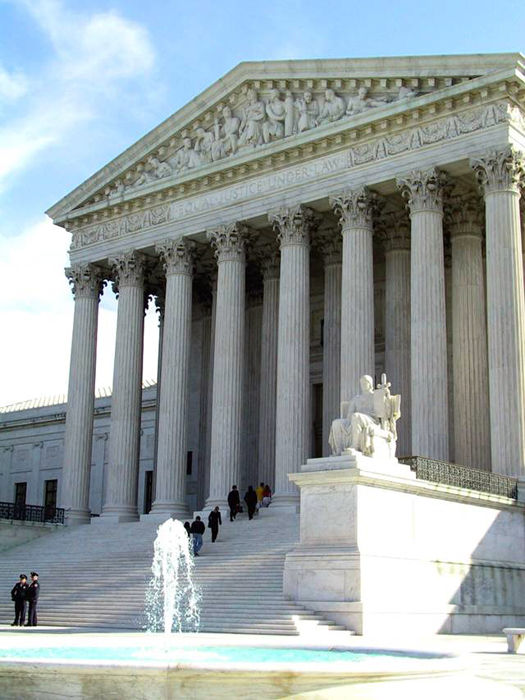
The relationship between the architecture of the Supreme Court and its landscaping is one of the most successful in Washington. The architect, Cass Gilbert, effectively disguised the irregular trapezoidal plot on which the building sits while totally controlling the approach, entrance, and passage through the building. The building is composed of three parts, a dominant temple of Roman derivation flanked by two wide horizontal wings. The temple, literally conceived of as the temple of justice, contains the most important functions, culminating in the Supreme Court chamber which terminates its 385-foot-long axis.
Sixteen columns (and eight pilasters) are Gilbert's American variant of the Corinthian order where heraldic eagles are set between splayed volutes.
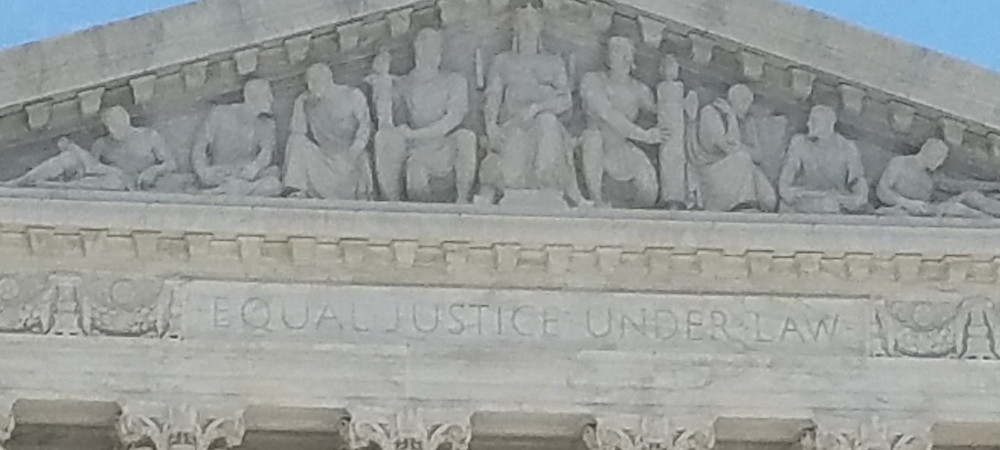
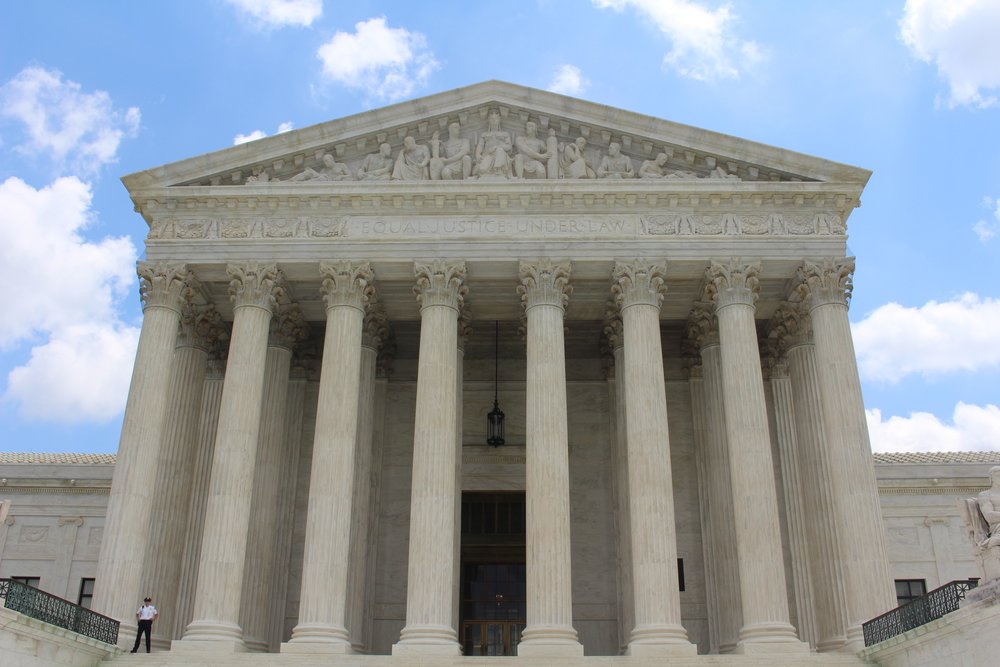
Designed by famed architect Cass Gilbert, the U.S. Supreme Court Building's west facade bears the phrase "Equal Justice Under Law." Inspired by ideals from the Fourteenth Amendment and Greek precedents, this phrase continues to represent American judicial ideals today.
The phrase "Equal Justice Under Law" traces its origins all the way back to the end of the Peloponnesian War at about 404 B.C.E. At the time, the renowned Greek general Pericles gave a famous speech in which he stated: "If we look to the laws, they afford equal justice to all in their private differences."
Over time, through numerous translations and with the introduction of the equal protection clause of the Fourteenth Amendment, this concept would slowly morph and shorten into the phrase engraved across the white marble facade of the Supreme Court Building: Equal Justice Under Law.
In the same speech in which he inadvertently coined what is now one of the most recognized phrases in modern-day America, Pericles also proclaimed "class considerations [are not] allowed to interfere with merit; nor again does poverty bar the way, if a man is able to serve the state, he is not hindered by the obscurity of his condition."
Pericles emphasized the fact that people's statuses, physical states, or levels of wealth should not hinder them from equal justice or from serving in certain positions.
https://equaljusticeunderlaw.org/thejusticereport/2018/8/29/equality-and-justice-history-and-ideals
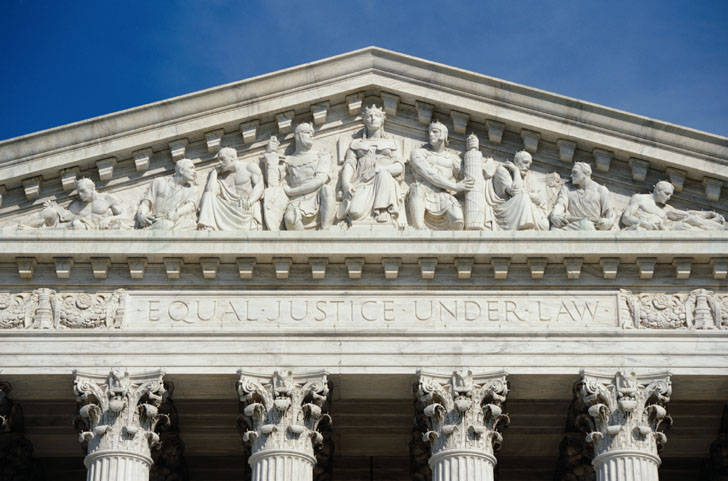
Five characters are allegorical:
- Liberty (in the middle, with the scales of justice, a symbol that originated in Babylonia and Egypt and predated the writing of the Ten Commandments)
- Order
- Authority
- two figures representing Council
The remaining individuals are candidly historical:
- Chief Justice William Howard Taft
- Senator Elihu Root
- Architect Cass Gilbert
- Chief Justice Charles Evans Hughes
- Sculptor Robert Aitken
- Chief Justice John Marshall
https://ffrf.org/publications/timeless-topics/item/15139-did-you-know
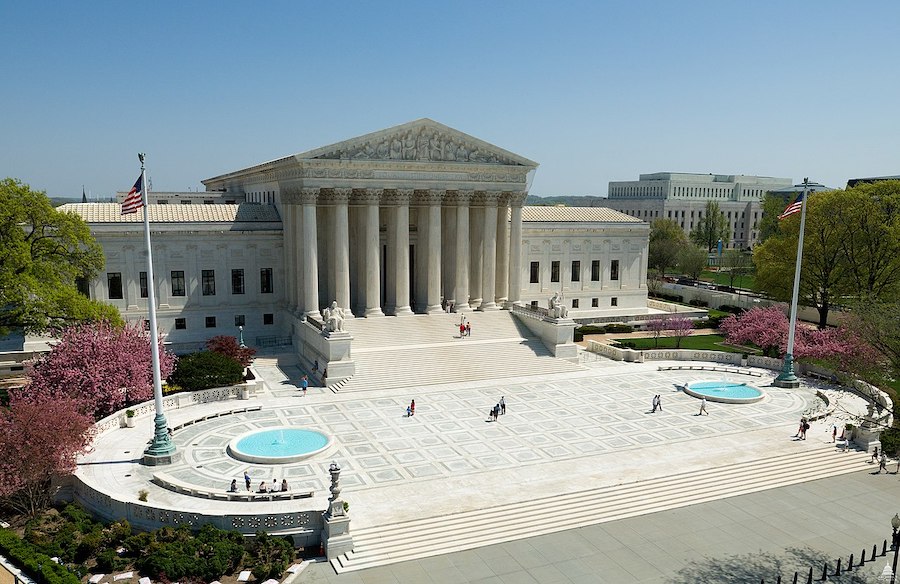
The Supreme Court Building has two flagpoles located symmetrically on the front plaza. At seventy-five feet high, each pole assembly includes an eight tiered bronze base, a fluted pole connecting the base to the flagpole, and an American eagle as the crowning ornamentation.
The bases of the flagpoles have elaborate decoration:
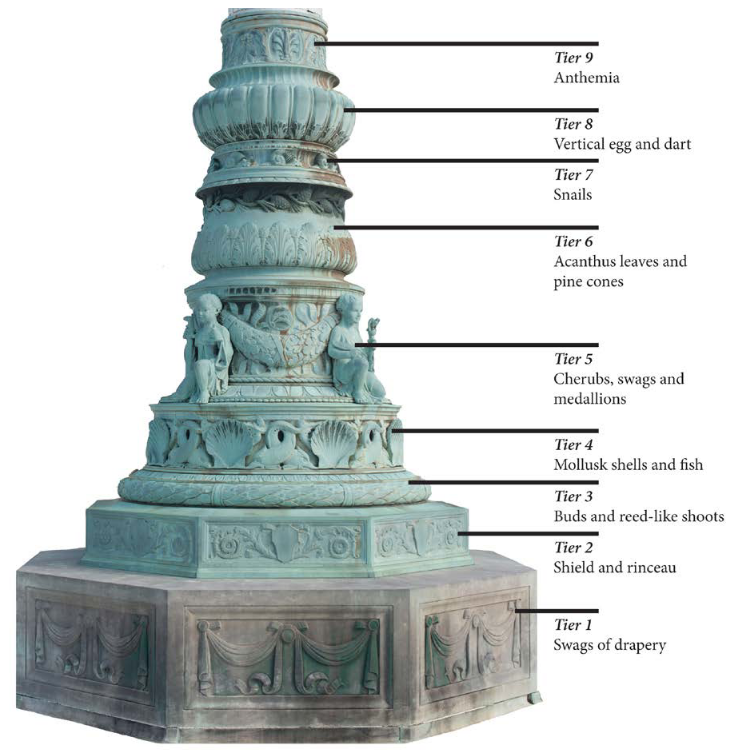
Four cherubs in loosely fitted robes kneel upon the fifth tier. One cherub holds the scales of justice as well as a sword, symbolizing authority. Another holds a book, symbolizing learning. The next holds the mask and the torch, symbolizing light removing the mask of untruth. The last cherub holds a Pen and Mace, symbolizing legislation. Between the cherubs are swags with four medallions above. Portrayed in the medallions are the four elements: air is represented by an eagle, water by a fish, earth by a lion's head, and fire by a tripod of flame.
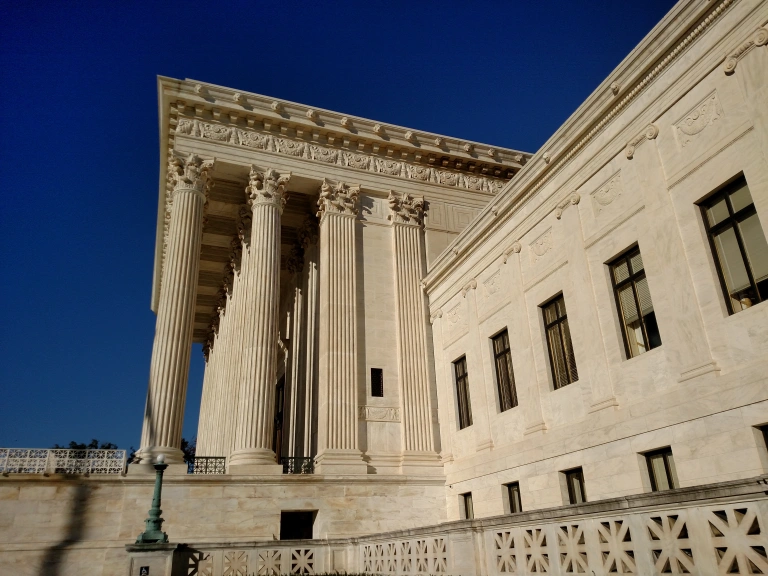
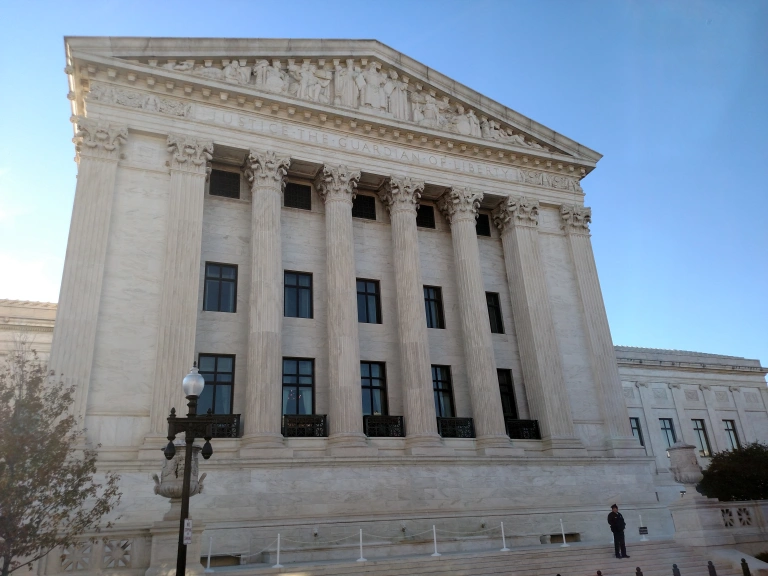
Back of the Building
https://historychaplain.wordpress.com/2016/10/25/u-s-supreme-court-building
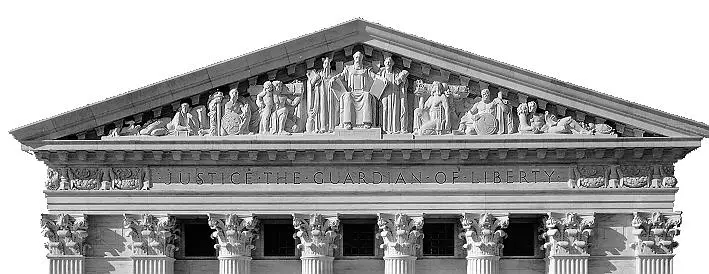
The inscription on the East Pediment: Justice the Guardian of Liberty. It is one of the few decisions regarding the architecture of the building that was made directly by one of the Justices. On May 2,1932, David Lynn, the Architect of the Capitol, sent Chief Justice Charles Evans Hughes a letter with Cass Gilbert's suggestions for the East and West Pediment inscriptions. The Chief Justice agreed with the suggested inscription for the West Pediment, Equal Justice Under Law, but did not like the one proposed for the East Pediment: "Equal Justice is the Foundation of Liberty".
Chief Justice Hughes sent a note with a suggestion for a different inscription to Justice Willis Van Devanter, the only Justice beside Hughes and his predecessor, Chief Justice William Howard Taft, to serve on the Supreme Court Building Commission. Justice Van Devanter responded with a succinct reply: "Good (W.V.)" A few days later, the Chief Justice formally answered Lynn's request by providing the alternate inscription, stating simply "We think that the inscription for the East Portico can be improved." The May 16, 1932 Note regarding the East Pediment Inscription written in the hand of Charles Evans Hughes, reads, I rather prefer "Justice the Guardian of Liberty"
https://hermonatkinsmacneil.com/2010/08/07/moses-confusius-and-solon-at-supreme-court
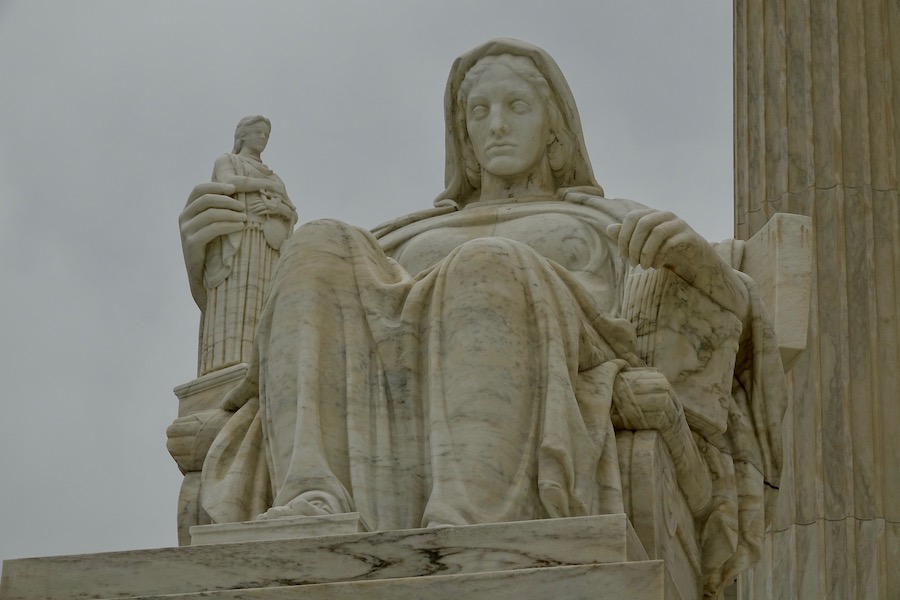
by sculptor James Earle Fraser. It's a meditating woman holding a book of law in one hand and a figure of Justice in the other. The Contemplation of Justice sits on the left side of the Supreme Court building.
https://www.wherearesueandmike.com/2018/06/capitol-building-and-supreme-court-in-dc
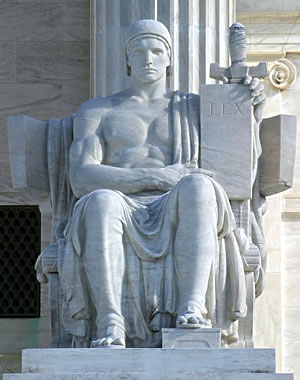
On the right-side of the entrance of the U.S. Supreme court is the statue entitled, Authority of Law. The statue's sword illustrates the enforcement power of the law. Instructively, the tablet of marble is inscribed with the Latin word, LEX, and it is in front of the sword. Lex is the Latin word for law. In other words, the statue teaches us that the power of the sword needs to be subservient to estabilished law and not the arbitrary orders of rulers.
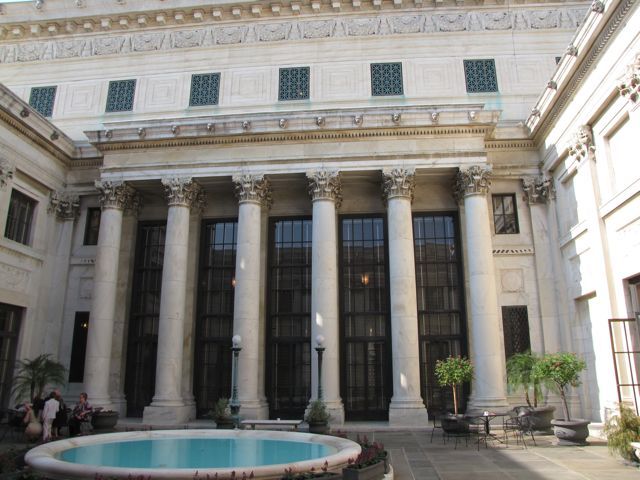
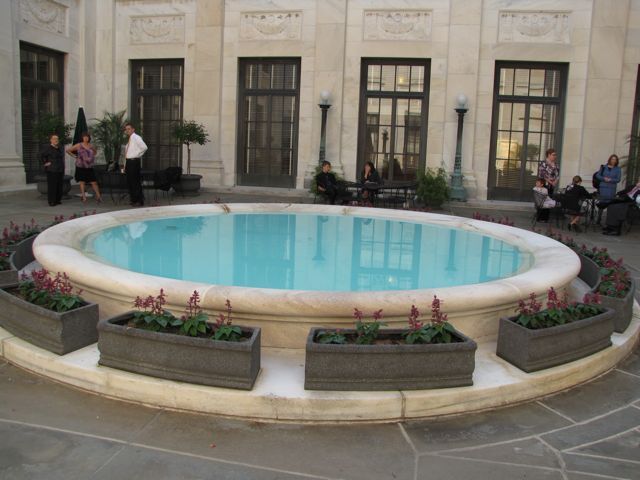
https://www.isba.org/barnews/2011/06/courthousetourussupremecourtphotoga
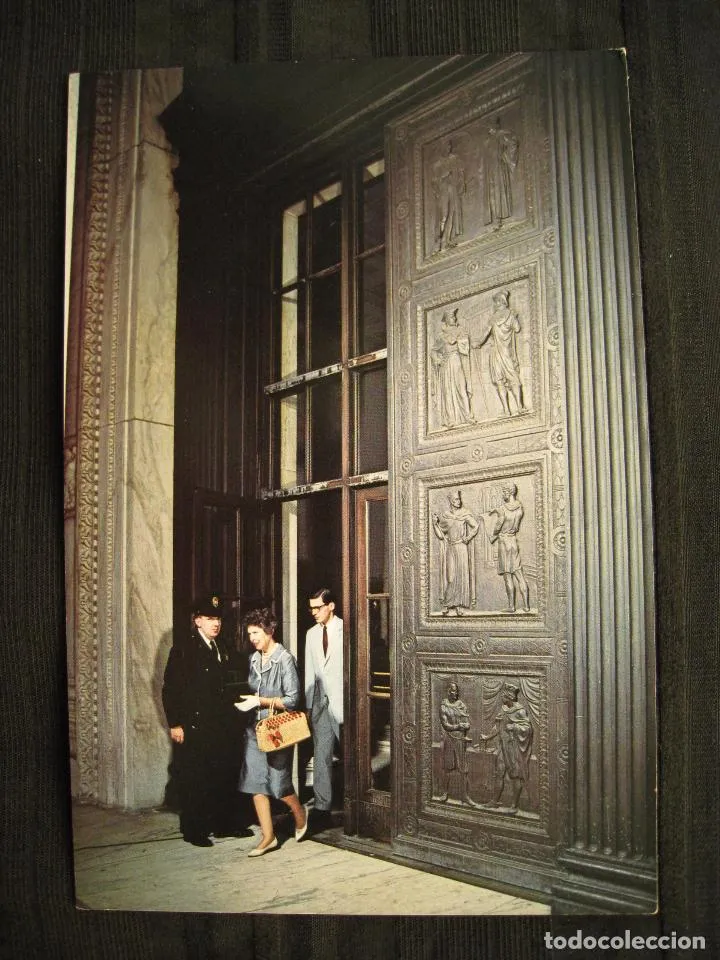
Massive sliding bronze doors of the Supreme Court Bullding in Washington, D.C. tell of the triumphs of mankind in the struggle for a just society; eight relief panels trace the evolution of law from ancient Greece and Rome to the young United States.
https://en.todocoleccion.net/postcards-america/postal-massive-sliding-bronze-doors-of-the-supreme-court-building-in-washington-d-c-x101472995
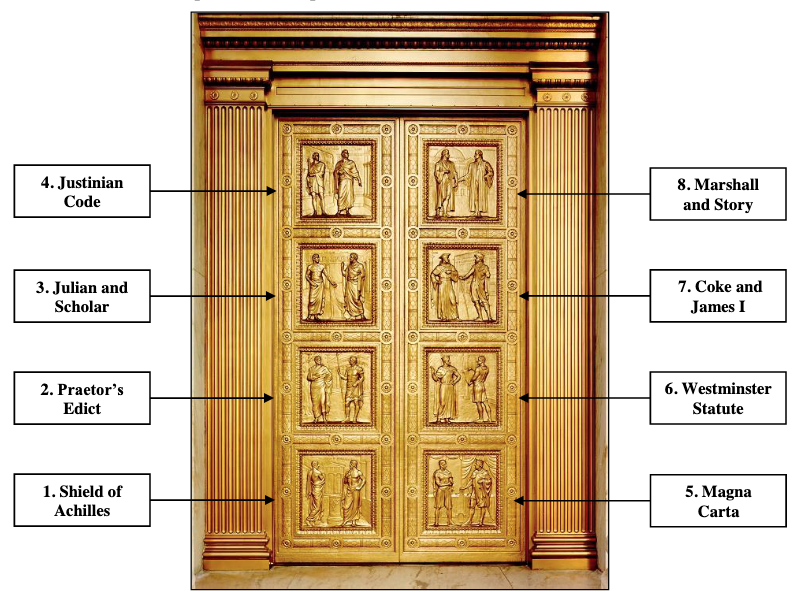
Each door is comprised of four bas-reliefs which illustrate significant events in the evolution of justice in the Western tradition. Arranged chronologically, the thematic sequence begins on the lower left panel and moves up to the top of that door. It continues with the bottom right panel and concludes with the upper right corner.
- Shield of Achilles
This panel depicts a scene found on the Shield of Achilles as described in Homer's Iliad. Two men bring a dispute before the elders (not depicted) who will each pass judgement. The elder with the fairest verdict will be awarded the two coins on the pedestal and his verdict is adopted by the whole body. - Praetor Edict:
A Roman praetor (magistrate) publishes his edict proclaiming the validity of judge-made or "common" law. On the right is a soldier, who may represent the power of government to enforce the common law. - Julian and Scholar:
Julian, one of the most prominent law teachers in Ancient Rome, instructs a pupil. According to the Donnellys, this represents "the development of law by scholar and advocate." - Justinian Code:
This panel depicts the publishing of the Corpus Juris by order of the Roman (Byzantine) Emperor Justinian in the sixth century AD. This is considered to be the first codification of Roman law. - Magna Carta:
King John of England is coerced by the Barons to place his seal upon the Magna Carta in 1215. - Westminster Statue:
King Edward I watches as his chancellor (secretary) publishes the Statute of Westminster in 1275. The Donnellys' description states "The greatest single legal reform in our history." - Coke and James I:
England's Lord Chief Justice Coke bars King James I from the "King's Court," making the court, by law, independent of the executive branch of government. - Marshall and Story:
The Donnellys describe this event as Chief Justice John Marshall and Associate Justice Joseph Story discussing the 1803 Marbury v. Madison opinion in front of the U.S. Capitol. It should be noted that Justice Story did not join the Court until 1812, nine years after this historic decision was handed down.
https://www.supremecourt.gov/about/BronzeDoors_11-8-2021.pdf
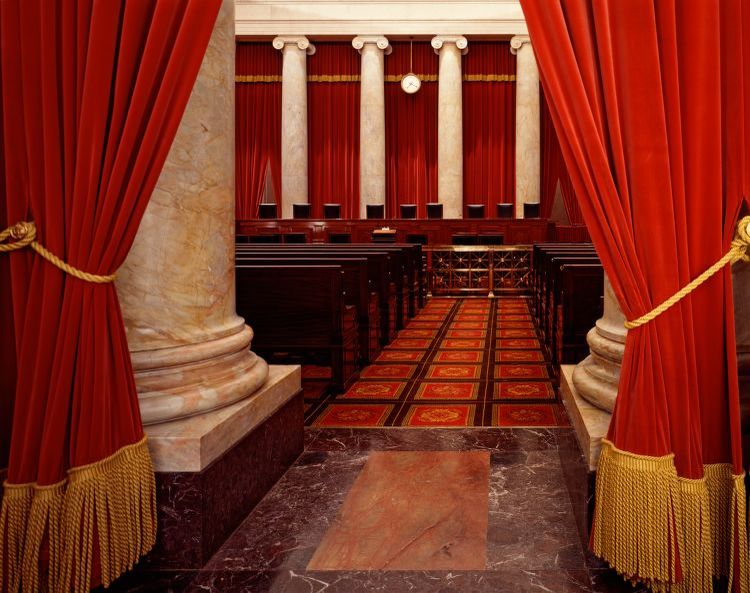
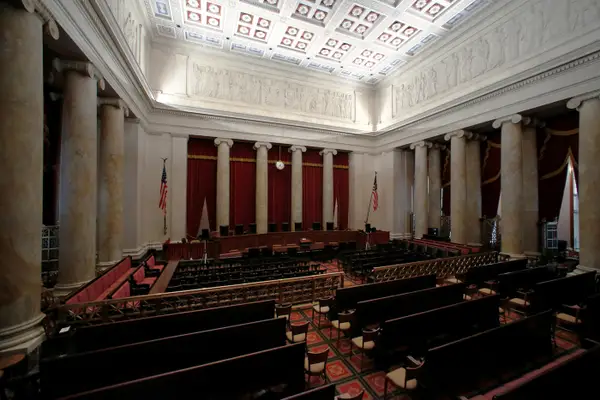
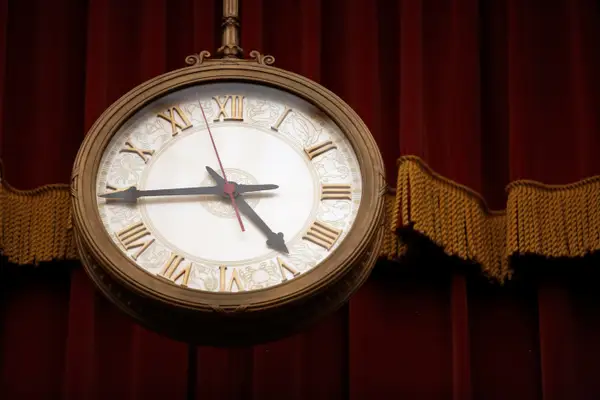
https://www.businessinsider.com/supreme-court-photos-2016-6
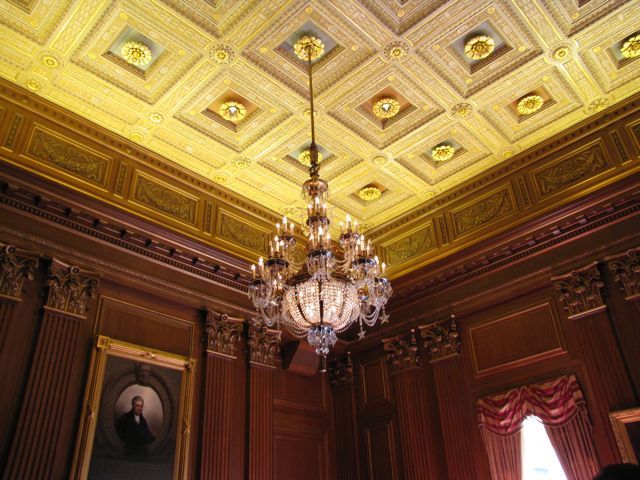
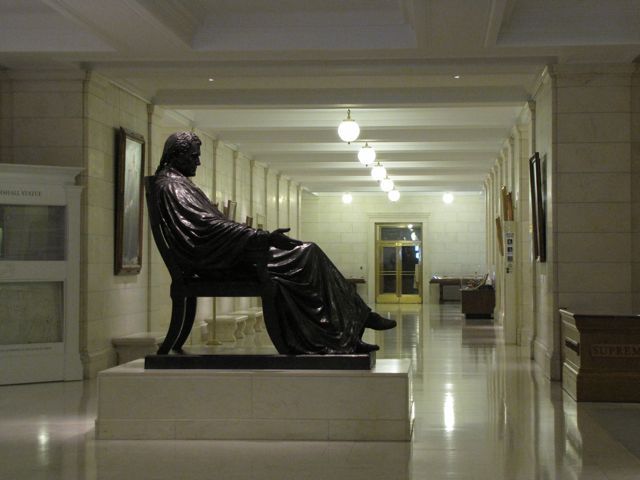
John Marshall Statue
https://www.isba.org/barnews/2011/06/courthousetourussupremecourtphotoga
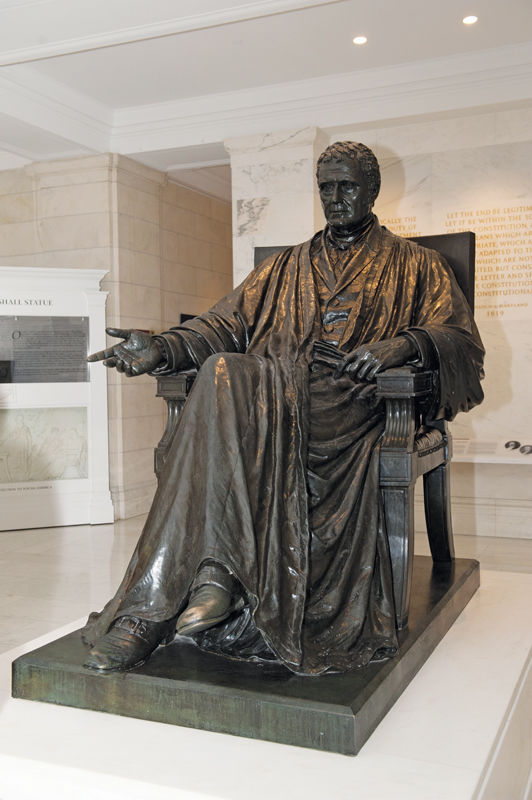
It's a tradition for attorneys to rub the feet of the bronze statue of Chief Justice John Marshall at the U.S. Supreme Court before going to argue before the court. This ritual supposedly brings good luck to the lawyers.
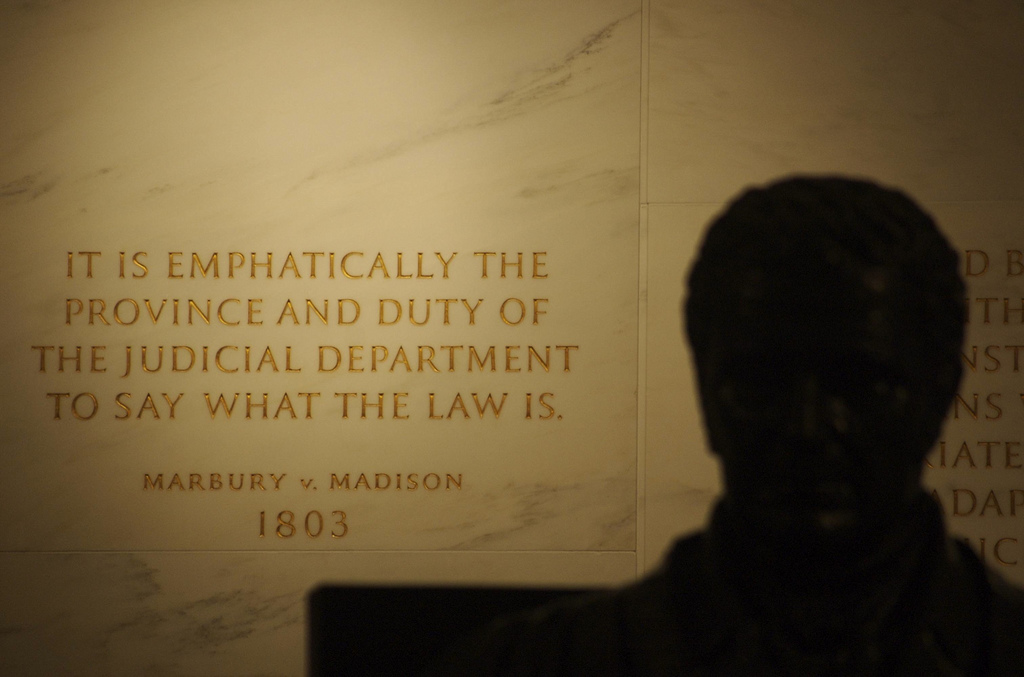
A landmark decision made by the Supreme Court under the leadership of Chief Justice, John Marshall, Marbury v Madison forever cemented the relationship between the different branches of the government by placing the power of "judicial review" firmly in the hand of the judicial branch. In a desperate last ditch attempt to secure some power for the Federalists, the Adams administration signed a number of judicial commissions into effect. William Marbury was intended to receive the position of the justice of peace of the District of Columbia, but the new Secretary of States, Madison, refused to send out the official commission Marbury with the job. Incensed, Marbury then took his case to the Supreme Court, thereby forcing Marshall between a rock and a hard place. Marshall knew that if he tried to advance the Marbury's case, he would face total rejection by the Democratic Republican, while weakening the power of the entire Judicial Branch. To find a political middle ground, Marshall dismissed Marbury's suit by arguing that the Judicial Act of 1789 was partially unconstitutional. Even through Marbury lost his commission, Marshall was able to pull a major victory out of the seeming defeat by setting a precedent under which the court had the final interpretation of the Constitution.
http://mstartzman.pbworks.com/w/page/21900513/Marbury%20v%20Madison
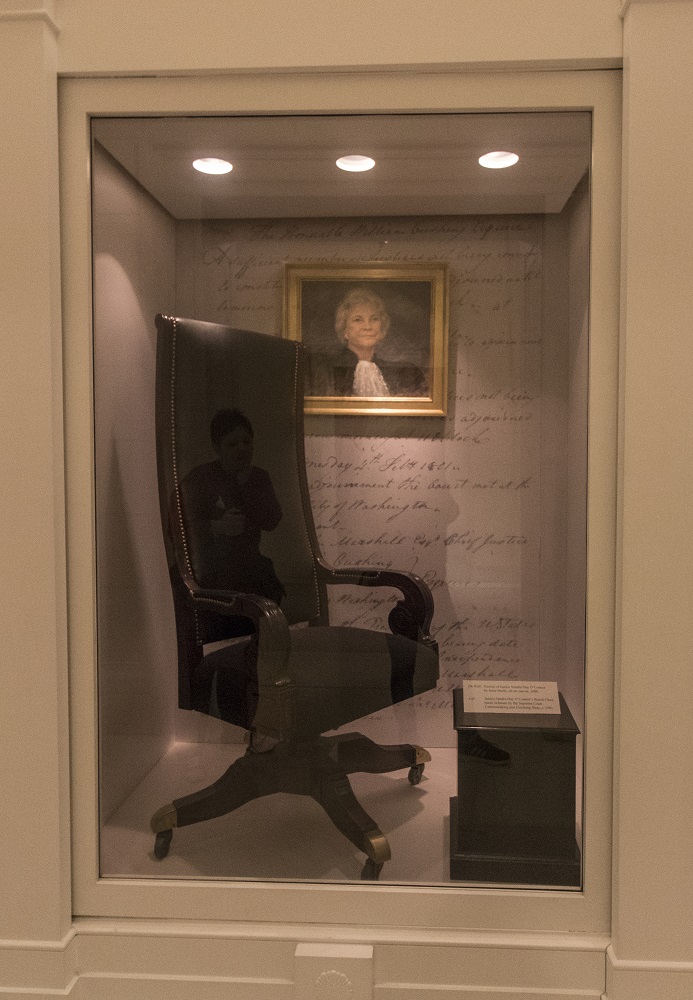
Appointed by President Reagan in 1981 becoming the first woman to be appointed in the U.S. Supreme Court. After she retired, she was awarded the Presidential Medal of Freedom by former President Obama for her work. The exhibit displays her original chair and a beautiful portrait of her.
Security is very tight within the Courtroom. Reporters and photographers go old-school with regular paper and pen
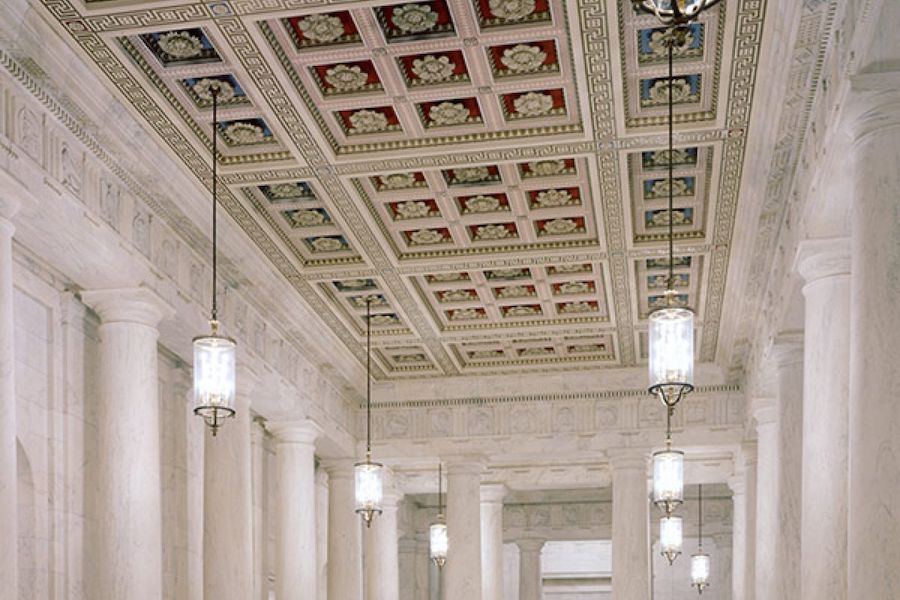
The main corridor, known as the Great Hall, has double rows of monolithic marble columns which rise to a coffered ceiling.
https://www.aoc.gov/explore-capitol-campus/buildings-grounds/supreme-court/supreme-court-building
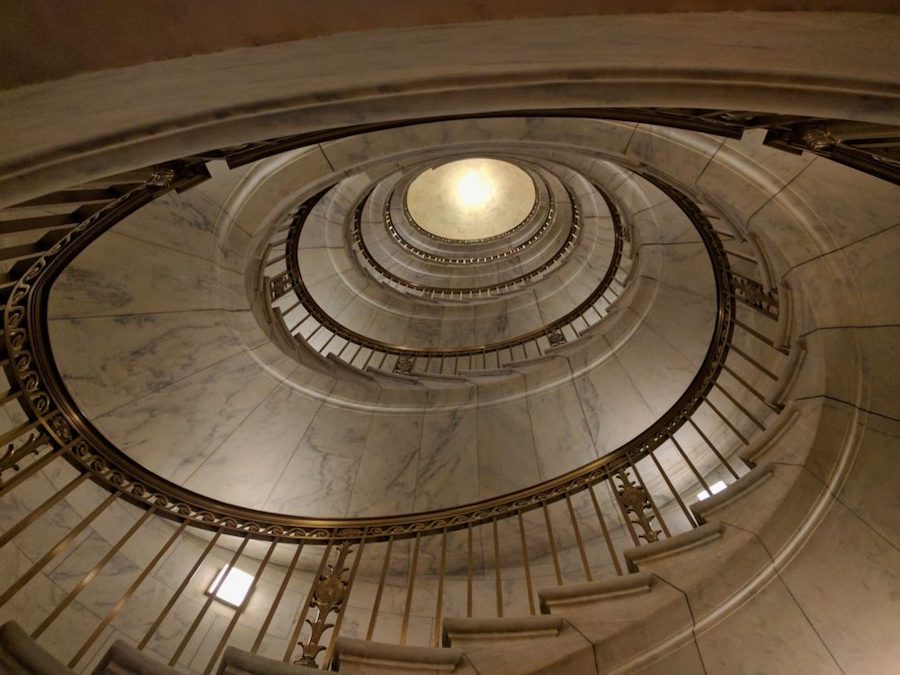
Each with 136 steps, two staircase holds seven spirals that ascend five stories, starting from the basement and up to the third floor. Each step is cantilevered into the outside marble wall and rests upon a step below it, eliminating the need for a central support.
https://www.trailandhitch.com/united-states-supreme-court-building
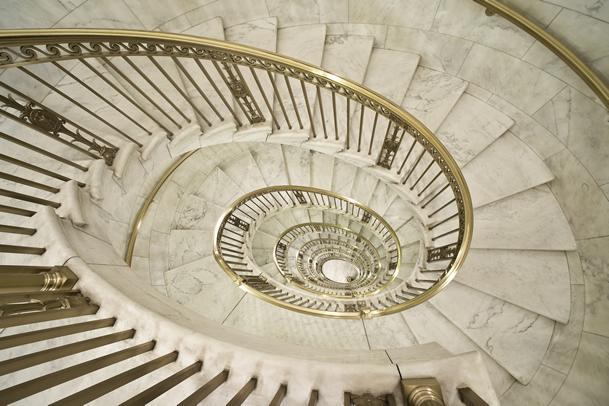
Whether Cass Gilbert, the building's architect, chose to include them for practical reasons or simply for their visual beauty is not known.
The cantilevered design of the staircases eliminates the need for a central support as each step is anchored into the marble wall on one end and rests upon the step below it. The staircases, therefore, are held in place by fit and pressure rather than mortar and steel.
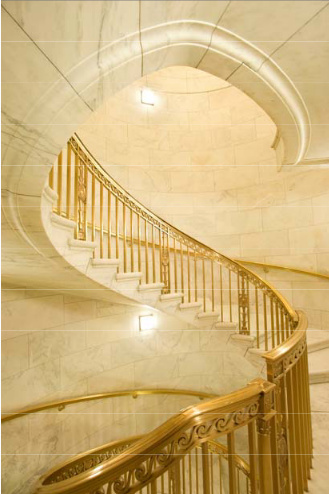
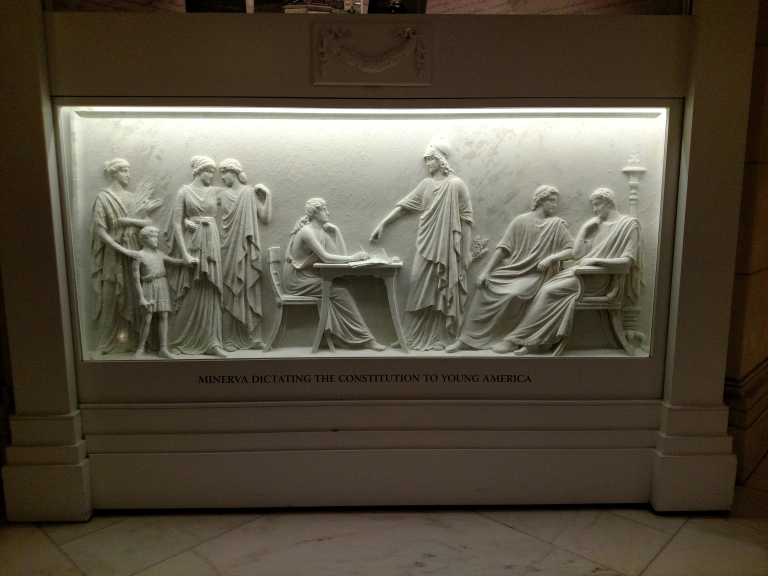
This relief also appears other places in D.C.
https://historychaplain.wordpress.com/2016/10/25/u-s-supreme-court-building
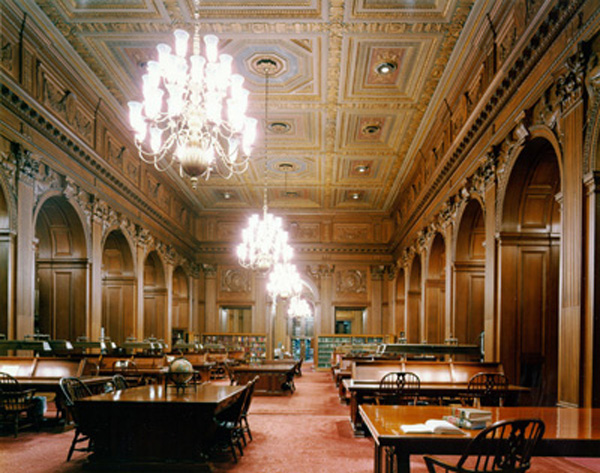
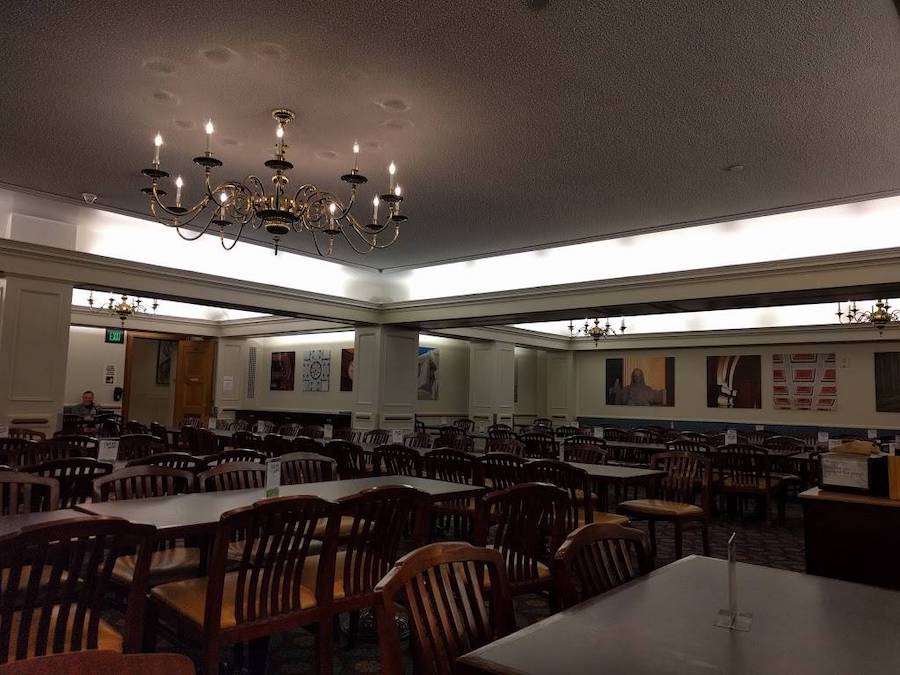
| P Murray: |
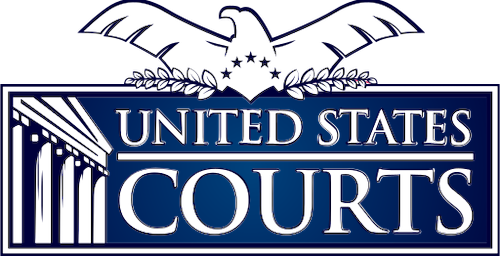 Background:
Background:Article III, Section 1 of the Constitution establishes the Supreme Court of the United States. Currently, there are nine Justices on the Court. Before taking office, each Justice must be appointed by the President and confirmed by the Senate. Justices hold office during good behavior, typically, for life.
The Constitution states that the Supreme Court has both original and appellate jurisdiction. Original jurisdiction means that the Supreme Court is the first, and only, Court to hear a case. The Constitution limits original jurisdiction cases to those involving disputes between the states or disputes arising among ambassadors and other high-ranking ministers. Appellate jurisdiction means that the Court has the authority to review the decisions of lower courts. Most of the cases the Supreme Court hears are appeals from lower courts.
Writs of Certiorari:
Parties who are not satisfied with the decision of a lower court must petition the U.S. Supreme Court to hear their case. The primary means to petition the court for review is to ask it to grant a writ of certiorari. This is a request that the Supreme Court order a lower court to send up the record of the case for review. The Court usually is not under any obligation to hear these cases, and it usually only does so if the case could have national significance, might harmonize conflicting decisions in the federal Circuit courts, and/or could have precedential value. In fact, the Court accepts 100-150 of the more than 7,000 cases that it is asked to review each year. Typically, the Court hears cases that have been decided in either an appropriate U.S. Court of Appeals or the highest Court in a given state (if the state court decided a Constitutional issue).
The Supreme Court has its own set of rules. According to these rules, four of the nine Justices must vote to accept a case. Five of the nine Justices must vote in order to grant a stay, e.g., a stay of execution in a death penalty case. Under certain instances, one Justice may grant a stay pending review by the entire Court.
| Current Justices: |
|---|
| https://www.supremecourt.gov/about/biographies.aspx |
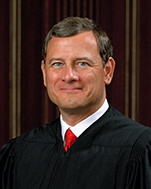 John G. Roberts, Jr. Born in Buffalo, New York, January 27, 1955. President George W. Bush nominated him as Chief Justice of the United States, and he took his seat September 29, 2005.Chief Justice |
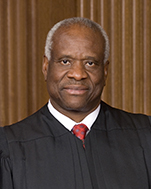 Clarence Thomas Born in the Pinpoint community near Savannah, Georgia on June 23, 1948. President George H.W. Bush nominated him as an Associate Justice of the Supreme Court and he took his seat October 23, 1991.Associate Justice |
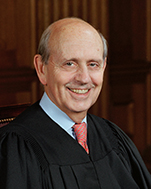 Stephen G. Breyer Born in San Francisco, California, August 15, 1938. President Clinton nominated him as an Associate Justice of the Supreme Court, and he took his seat August 3, 1994.Associate Justice |
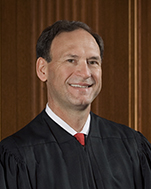 Samuel A. Alito Born in Trenton, New Jersey, April 1, 1950. President George W. Bush nominated him as an Associate Justice of the Supreme Court, and he took his seat January 31, 2006.Associate Justice |
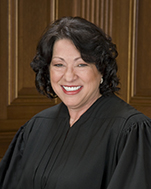 Sonia Sotomayor Born in Bronx, New York, on June 25, 1954. President Barack Obama nominated her as an Associate Justice of the Supreme Court on May 26, 2009, and she assumed this role August 8, 2009.Associate Justice |
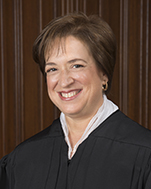 Elena Kagan Born in New York, New York, on April 28, 1960. President Barack Obama nominated her as an Associate Justice of the Supreme Court on May 10, 2010. She took her seat on August 7, 2010.Associate Justice |
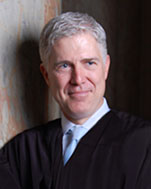 Neil M. Gorsuch Born in Denver, Colorado, August 29, 1967. President Donald J. Trump nominated him as an Associate Justice of the Supreme Court, and he took his seat on April 10, 2017.Associate Justice |
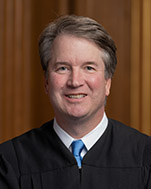 Brett M. Kavanaugh Born in Washington, D.C., on February 12, 1965. President Donald J. Trump nominated him as an Associate Justice of the Supreme Court, and he took his seat on October 6, 2018.Associate Justice |
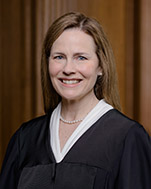 Amy Coney Barrett Born in New Orleans, Louisiana, on January 28, 1972. President Donald J. Trump nominated her as an Associate Justice of the Supreme Court, and she took her seat on October 27, 2020.Associate Justice |
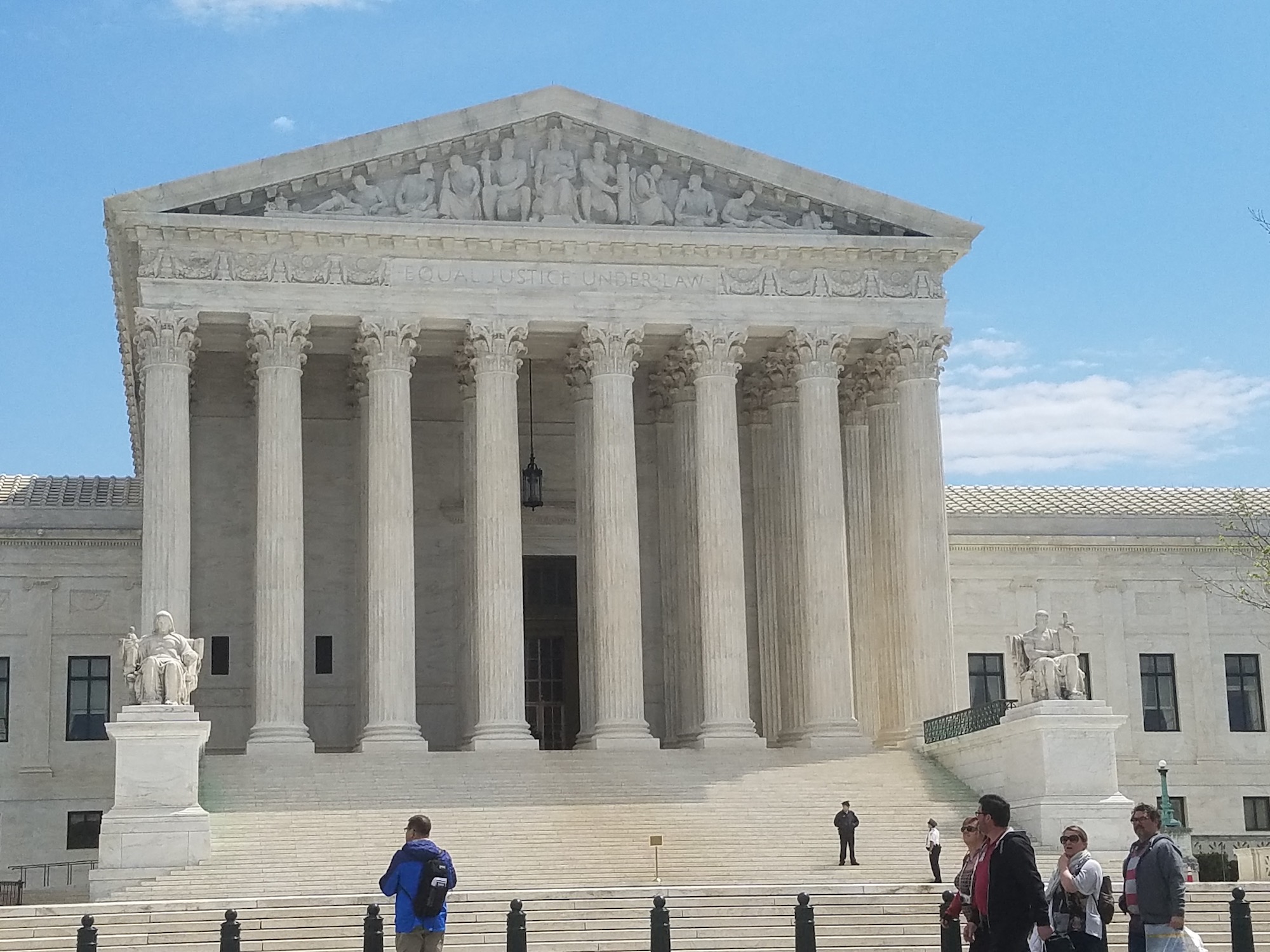
The Supreme Court of the United States (SCOTUS) is the highest court in the federal judiciary of the United States of America.Supreme Court of the United States:
- It has ultimate and largely discretionary appellate jurisdiction over all federal and state court cases that involve a point of federal law.
- It has original jurisdiction over a narrow range of cases, specifically "all Cases affecting Ambassadors, other public Ministers and Consuls, and those in which a State shall be Party.
- The Court holds the power of judicial review, the ability to invalidate a statute for violating a provision of the Constitution.
- It is also able to strike down presidential directives for violating either the Constitution or statutory law.
It may act only within the context of a case in an area of law over which it has jurisdiction. The Court may decide cases having political overtones but has ruled that it does not have power to decide non-justiciable political questions.
- Established by Article Three of the United States Constitution, the composition and procedures of the Supreme Court were initially established by the 1st Congress through the Judiciary Act of 1789.
- As later set by the Judiciary Act of 1869, the Court consists of the chief justice of the United States and eight associate justices.
- Each justice has lifetime tenure, meaning they remain on the Court until they die, retire, resign, or are removed from office.
- When a vacancy occurs, the president, with the advice and consent of the Senate, appoints a new justice.
- Each justice has a single vote in deciding the cases argued before the Court.
- When in majority, the chief justice decides who writes the opinion of the court; otherwise, the most senior justice in the majority assigns the task of writing the opinion.
https://en.wikipedia.org/wiki/Supreme_Court_of_the_United_States



